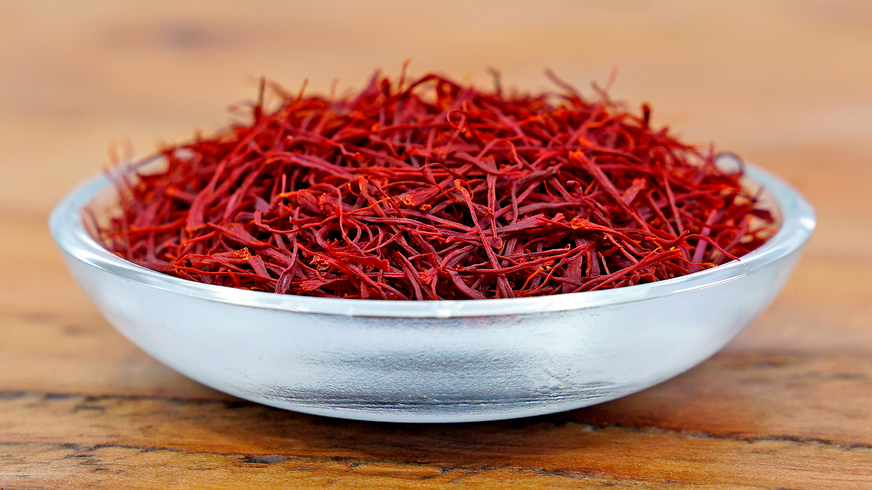


Saffron
Estimated Inventory, lb : 0
Description/Taste
Saffron threads are thin and long with a glossy sheen. The spice has a deep orange-red color and a smooth, malleable consistency. Saffron threads are highly aromatic with floral notes of hay and honey. The flavor of Saffron is unique, with bitter and earthy undertones mixed with floral honey highlights and a slightly metallic finish.
Seasons/Availability
Dried Saffron threads are available year-round, with fresh threads harvested in the fall.
Current Facts
Saffron threads are the pungent stigmas of the light purple Crocus flower, botanically classified as Crocus sativus. The Crocus sativus variety was propagated from a wild type of the Crocus plant to develop three abnormally long stigmas. The pollen-bearing structures of the flower are harvested by hand in the autumn on the morning it first blooms. Saffron cultivation is incredibly labor-intensive, and a pound of saffron requires over 70,000 blossoms, resulting in Saffron being the world’s most expensive spice, with one pound often exceeding $4,000 in cost. The exorbitant price of the spice has been the cause of multiple wars, including the fourteen-week-long “Saffron War” in 14th century Europe. Crocus sativus is the only true Saffron variety, although there are many copycats and knock-off varieties sold. Two such types, American and Mexican saffron, are made from safflower and give a similar color to true Saffron but not the distinct flavor or aroma of the rare spice. Saffron has been used throughout history in cosmetics, medicine, and as a dye for fabrics and ink, especially by royalty, who used it to symbolize their wealth and power.
Nutritional Value
Saffron is rich in vitamin A, folic acid, riboflavin, and vitamin C. The spice has a high level of antioxidants, micronutrients that help to fight against free radicals within the body. The dried stigma contains carotenoids which help to boost the body’s immune system. Historically, Saffron has been used to reduce pain and inflammation in the body. Today, Saffron is mixed with milk and used as a remedy to relieve cramps and other discomforts associated with menstruation.
Applications
Saffron is used to color and flavor a variety of dishes across many different cultures. The most popular dish featuring Saffron is Spanish paella. The aromatic spice is mixed into the rice of this crispy seafood dish, creating a distinct flavor and smell. Saffron is commonly used to flavor bread in English, Scandinavian, and Balkan cuisine and to flavor rice and fish dishes in Mediterranean and Asian cuisines. Saffron threads should be crushed and steeped in warm liquid until they have released their flavor and color. This liquid can then be added to grains, stews, soups, and braised meats towards the end of cooking. The threads can also be toasted, ground, and added to spice mixtures, sprinkled over fish, vegetables, and potatoes. Saffron pairs well with seafood, poultry, lemon, ginger, tomatoes, and aromatic herbs like thyme and marjoram. Saffron threads should be stored in an air-tight container in a cool and dry place to help keep them fresh. The threads should also be used within six months for optimum flavor.
Ethnic/Cultural Info
Historically, Saffron has been used worldwide, primarily grown in the Middle East, but it has also been produced on a much smaller scale in North America. The spice was imported to the region in the 18th century when thousands of Alsatians, Germans, Swiss, and others fled to the colonies to escape religious persecution. This group settled in Eastern Pennsylvania and became known as the Pennsylvania Dutch. A German group among the settlers, known as the Schwenkfelders, brought the seeds with them, and by 1730, Saffron was widely cultivated within the settlement. The Pennsylvania Dutch exported the spice to Spanish colonists in the Caribbean and other areas with a price equal to that of gold at the time. This trade continued until the War of 1812 when many of the merchant vessels that transported the spice to the Caribbean were destroyed. While the Pennsylvania Dutch continued to grow the spice and use it for their own culinary, cosmetic, and dyeing purposes, the trade to the Caribbean never recovered. Today, the Pennsylvania Dutch continue to cultivate the prized flower, and a push to grow Saffron elsewhere on the East Coast of the United States is rising. In 2015, the University of Vermont established the North American Center for Saffron Research and Development, which hosts Saffron workshops annually to educate local farmers on the best cultivation methods for the spice.
Geography/History
Saffron is believed to be native to the Mediterranean, Asia Minor, and Iran, although its exact origin is unknown. The flower was first cultivated in Greece more than 3,000 years ago, and the Greeks are responsible for creating the hybridized version of Saffron known today. Saffron was introduced to Europe along Arab trade routes, and by the 10th century, the spice was widely cultivated in Spain. By the 12th century, the crop was introduced to China, gaining popularity in the surrounding regions. The crusades spread the crop further into Europe, where it was used medicinally to treat a variety of ailments. Cultivation of the crop rose exponentially in the 14th century as plague healers touted the flower's healing properties as a way to prevent and treat the sickness ravaging the area. Saffron was introduced to the New World by settlers fleeing religious persecution in the 18th century. This group began growing the flower in Pennsylvania, where it is still grown in small quantities today. Today, Iran produces 85% of the world’s Saffron crop. Other producers of Saffron include Spain, Greece, Turkey, Afghanistan, and parts of India. Saffron can be found at many high-end grocery stores or spice shops, but often it is kept locked up due to its high value.
Recipe Ideas
Recipes that include Saffron. One




